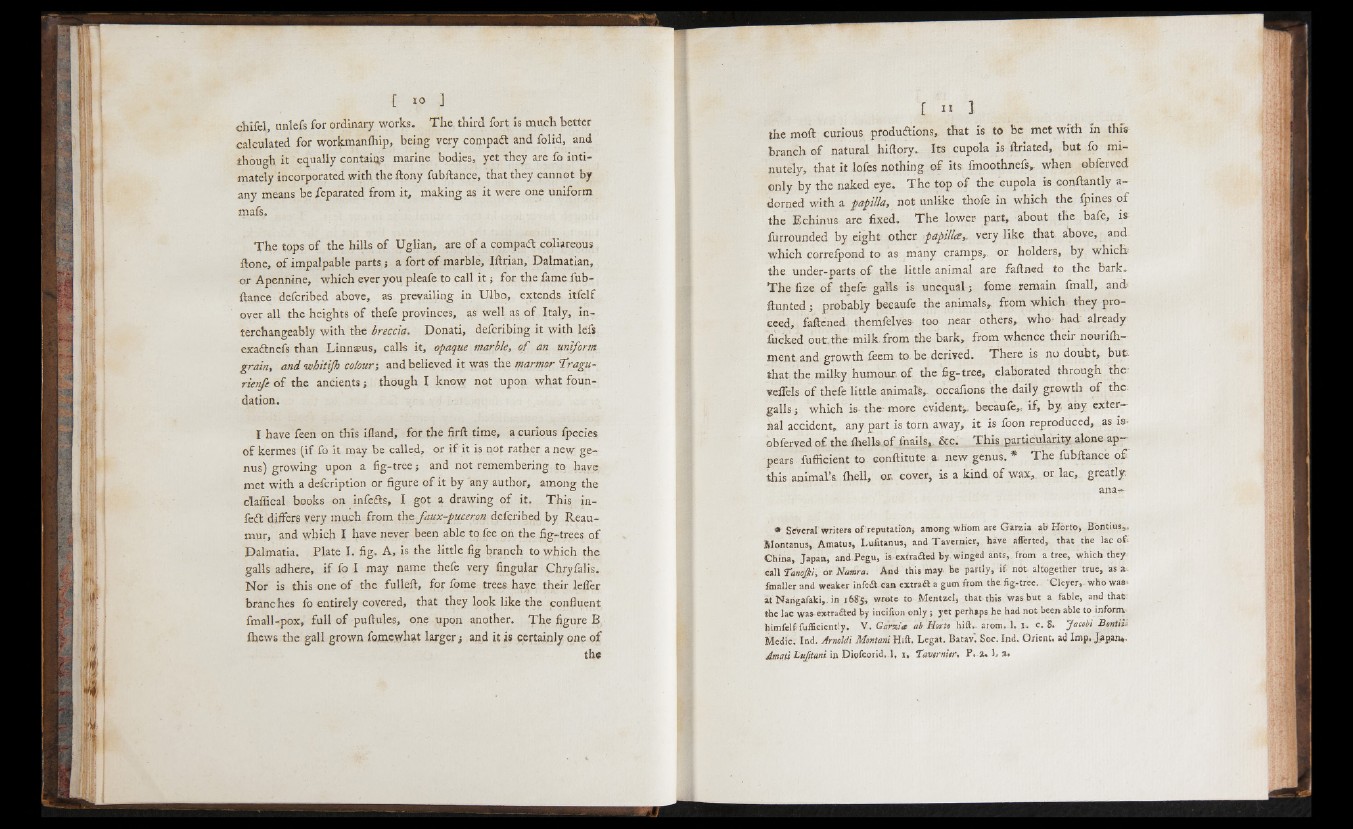
chifel, unlefs for ordinary works. T he third fort is much better
calculated for workmanihip, being very compadt and folid, and
though it equally contains marine bodies, yet they are fo intimately
incorporated with the itony fubftance, that they cannot by
any means be feparated from it, making as it were one uniform
mafs,
The tops o f the hills o f Uglian, are of a compad coliareous
ftone, o f impalpable parts; a fort o f marble, Iftrian, Dalmatian,
o r Apennine, which ever you pleafe to call it j for the fame fubftance
defcribed above, as prevailing in Ulbo, extends itfelf
over all the heights o f thefe provinces, as well as o f Italy, interchangeably
with the breccia. Donati, defcribing it with lefs
exadnefs than Linnaeus, calls it, opaque marble, o f an uniform
grain, and •whitijh colour-, and believed it was the marmor firagu-
rienfe o f the ancients; though I know not upon what foundation.
I have feen on this iiland, for the firft time, a curious lpecies
of kermes (if fo it m a y be c a lle d , or i f it is not rather a new genus)
growing upon a fig-tree; and not remembering to have
met with a defcription or figure o f it by any author, among the
claffical books on infeds, I got a drawing o f it. This in-
fed differs very much from the faux-puceron defcribed by Reaumur,
and which I have never been able to fee on the fig-trees o f
Dalmatia. Plate I. fig. A, is the little fig branch to which the
galls adhere, i f fo I may name thefe very fingular Chryfalis.
Nor is this one o f the fulleft, for fome trees have their leffer
branches fo entirely covered, that they look like the confluent
fmall-pox, full o f puftules, one upon another. The figure B
ihcws the gall grown fome,what larger; and it is certainly one o f
the
[ « 1
the moft curious produdions, that is to be met with in this
branch o f natural hiftory.. Its cupola is ftriated, but fo minutely,
that it lofes nothing o f its fmoothnefs, when obferved
only by the naked eye. The top o f the cupola is conftantly a -
dorned with a papilla, not unlike thofe in which the fpines of
the Echinus are fixed. T he lower part, about the bafe, is
furrounded by eight other papilla„ very like that above, and
which correipond to as many cramps,, or holders, by which
the under-parts o f the little animal are faftned to the bark.
T he fize o f thefe galls is unequal; fome remain imall, and«
ftunted; probably beeaufe the animals» from which- they proceed,
fattened, themfelves too near others, who- had: already
lucked o u t the milk from the bark, from whence their nourilh-
mentand growth feem to be derived. There is no doubt, b u t
that the milky humour o f the fig-tree, elaborated through the-
veffcls o f thefe little animals, occafions the daily growth o f the:
galls; which is-the-more evident», beeaufe, if; by, any external
accident, any part is torn away, it is foon reproduced, as is»
obferved o f the fiiells o f fnails, &c. This particularity alone appears
fufficient to conftitute a new genus. * The fubftance o f
this animalls. {hell, on cover, is a kind o f wax,, or lac, greatly.
ana-
* Several writers o f reputation; among whom are Garcia ab Hbrto; Bontius,,
Montanus, Amatus, Luiiunus, and Tavernier, have aBerted, that the lac of-
China, Japan, and Pegu, is exirafled by winged ants, from a tree, which they
call Tanojki, or. Namra. And this may- be partly, if- not. altogether true, as a-
fmaller and weaker infea.can extrail a gum from the. fig-tree. Cleyer,.who war-
at Nangafaki,. in 1685, wrote to Mentzel, that this was but a fable, and that
the lac was- extrailed by incifion only; yet perhaps he had not been able to inform
himfelf fuificiently. V . Gar%i<£ ah Horto hift. arom. 1. I . c. 8. Jacobi Bontiii
Medic. Ind. ArnoUi Mantani Hift. Legat. Batav. Soc. Ind. Orient, ad Imp. Japan,
dmati Lufitani in Diofcorid. l, 1, TavtrnUr, P . a. b a.